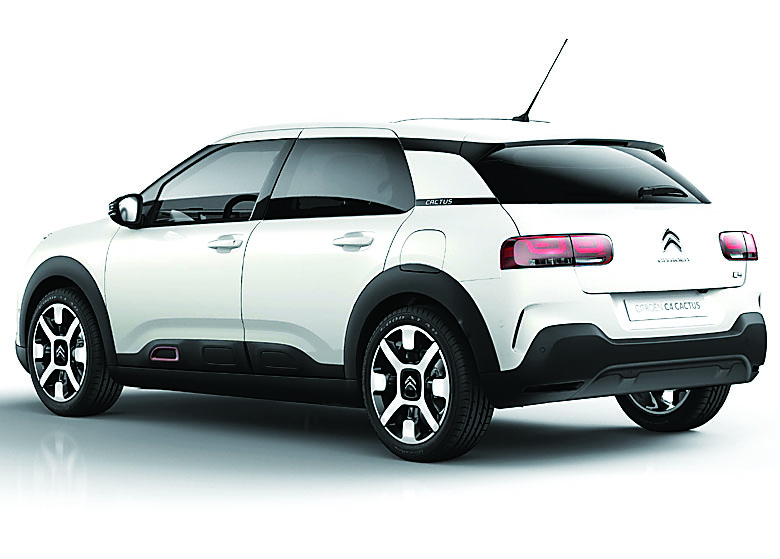From the daft name to the eye-catching ‘airbumps’ strewn across the side panels, everything about the previous-generation Citroen C4 Cactus was designed to be just a little bit different.
But with the new C3 Aircross taking its place as the mini-SUV in Citroen’s range, the C4 Cactus has moved upmarket to fill the void left by the C4 hatchback when it was taken off sale last year.
That gives it a mixture of mini-SUV and hatchback styling cues, and a price tag somewhere between the two market sectors. It also debuts some innovative new tech that will eventually be rolled out to most of Citroen’s cars.
The big news is Citroen’s ‘Advanced Comfort’ system. Anybody who’s driven a Citroen built in the Nineties or earlier can’t help but remember the pillowy ride bestowed by sophisticated hydraulic suspension - and that’s what the brand has tried to recreate on the Cactus.
It’s not a full hydraulic system, but it gains hydraulic dampers on either side of the usual shock-absorber to help reduce the impact from bumps, while still keeping the car stable. Advanced Comfort also brings added soundproofing and some excellent new seats, which are very comfortable indeed and a real highlight of the car’s interior.
The petrol-focused lineup consists of three versions of the 1.2-litre PureTech engine. The entry-level car has just 82hp, which is fine around town but gutless on the motorway. The higher-powered 110hp unit is the pick of the range with plenty of punch, though it’s mated to a baggy five-speed manual gearbox. The six-speed ‘box that comes with the 130hp engine is far superior.
There’s also a diesel unit, which offers incredible fuel economy, but the petrols are so good, it’s not really necessary. There’s also a six-speed automatic available on some models, but it’s not the best either - hesitant at take-off and has a tendency to jerk when you put your foot down. One thing common to all models is the lack of a rev counter; an irritating omission.
The trick suspension is undoubtedly clever, and gives the car a comfortable ride over all surfaces. It’s not the sort of quantum leap we were hoping for though, and the Cactus is no luxury limo. Also, while it copes well with bumpy roads, the suspension is uncomfortably floaty on motorways and smooth A-roads - we suspect it might make a few back-seat passengers car sick. Head into a corner with a bit of speed and the Cactus remains quite flat, but the lifeless and over-light steering doesn’t inspire much confidence. It’s certainly not a sports car, but most buyers won’t care about that.

The first Cactus was instantly recognisable, with massive plastic ‘airbumps’ panels on the side. The new model tones this down, and the airbumps are smaller - while the remainder of the body has been smoothed over, and there are new 3D-effect taillights. The stacked front headlight arrangement remains, with LED daytime running lights set above head and fog-lamps, while the distinctive grille includes Citroen’s double chevron logo. Inside, very little has changed, but the centre console has had a mild redesign. It’s still fairly stylish though, with a suitcase-style glovebox and leather straps acting as door pulls.
The Cactus’ stylish interior is a little compromised. Everything’s controlled by a large central touchscreen, which sounds like a good idea. However, in practice, having vitals such as the air-conditioning on there makes it awkward to adjust settings on the move, and the screen isn’t sufficiently responsive to justify this.
The cabin is roomy though, and very comfortable thanks to the new seats. These use a clever arrangement of varying density foam, so while they look flat and unsupportive, they’re remarkably body-hugging and accommodating.
The main trim levels are ‘Feel’ and ‘Flair’, which both come generously equipped. Base spec ‘Feel’ models get a seven-inch touchscreen with DAB radio, Apple CarPlay and Android Auto, Bluetooth and USB connectivity, air-conditioning and cruise control. Electric front windows are also standard, but the rears simply pop-out, so there’s no electric control there. ‘Flair’ adds sat-nav and a reversing camera, while all models can be personalised with exterior colours, different wheels and interior ‘moods’.
In losing some of its quirky charm, the new Cactus won’t be an immediate love affair for buyers as the first one was. However, it’ll undoubtedly appeal to a bigger group of people, and there’s no denying the new hydraulic suspension gives it a seriously comfortable USP. No version is truly without compromise though, so there’s still a certain level of irritating quirks you’ll have to put up with. Nevertheless, it’s interesting, decent to drive and cheap to own, which alone should be enough to put it on your shortlist.









